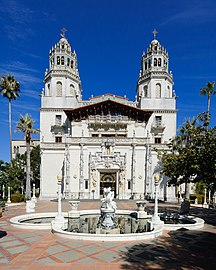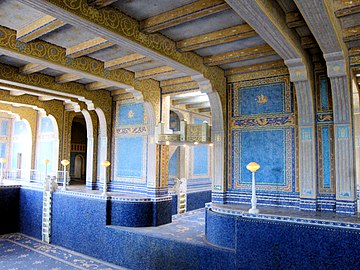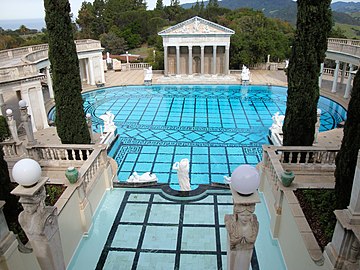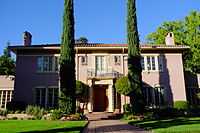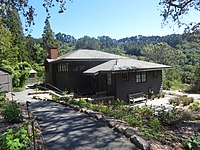Julia Morgan
Julia Morgan | |
|---|---|
Los Angeles Examiner Building The YWCA in Chinatown, San Francisco Riverside Art Museum Asilomar Conference Grounds | |
| Projects | Hearst Castle |
Julia Morgan (January 20, 1872 – February 2, 1957) was an American architect and engineer.[1][2] She designed more than 700 buildings in California during a long and prolific career.[3] She is best known for her work on Hearst Castle in San Simeon, California.[4]
Morgan was the first woman to be admitted to the architecture program at
In many of her structures, Morgan pioneered the aesthetic use of
Julia Morgan was the first woman to receive the American Institute of Architects highest award, the AIA Gold Medal, posthumously in 2014.[7]
Early life and education
Childhood
Morgan, the daughter of Charles Bill Morgan and Eliza Woodland Parmelee Morgan, was born on January 20, 1872, the second of five children. Her mother, Eliza, grew up as the indulged daughter of Albert O. Parmelee, a cotton trader and millionaire who financially supported the couple when they moved to San Francisco.[8] Two years after their daughter's birth, the Morgans moved to a home they had built in the suburb of Oakland. Though the Morgans resided on the West Coast, Eliza still kept close ties with her family. Upon the birth of each Morgan child, the Parmelees sent funds for the family to travel by the transcontinental railroad so that the infant could be christened in the traditional Parmelee family church in New York.[9]
Charles Morgan, a mining engineer from New England who had married into a wealthy family, did not succeed in any of his business ventures, so the family relied heavily on the Parmelee fortune.
Education
Morgan graduated from
One of the engineering lecturers of her senior year was
In principle, the school admitted the top 30 candidates. It took Morgan three tries to get in: on the first try, she placed too low, while on her second try, in 1898, although she placed well into the top 30, the examiners "arbitrarily lowered" her marks.[17][19] After more than a year of further study, tutored by François-Benjamin Chaussemiche, a winner of the Prix de Rome, she finally passed the entrance exams in the Architecture Program, placing 13th out of 376 applicants, and was duly admitted.[17] However, she could study only until her 30th birthday, as the school prohibited older scholars. In early 1902, as her birthday approached, Morgan submitted an outstanding design for a palatial theater. This earned her a certificate in architecture, making her the first woman to receive one from the school; she did so in three years, although the usual time of completion was five years (that was how long Maybeck took, for example).[12][17][20] She stayed in Paris long enough to collaborate with Chaussemiche on a project for Harriet Fearing, an ex–New Yorker who contracted for a "grand salon" design for her residence in Fontainebleau.[2]
Career
Upon her return from Paris, Morgan began working for San Francisco architect
In 1904, Morgan was the first woman to obtain an architecture license in California.[10][21][12] While living at the old family home in Oakland, she opened her own office in San Francisco, where the staff knew her as 'J.M.' After her first office was destroyed by the 1906 fire, she opened her office in 1907 on the 13th floor of the Merchants Exchange Building, 465 California Street, in the heart of San Francisco's financial district, where she worked for the rest of her career. In 1907 she partnered with Ira Hoover, former draftsman of Howard. Aptly named Morgan and Hoover, the two worked together until 1910.[22] Morgan reestablished an individual private practice in late 1910.
In April 1904, Julia Morgan completed her first
The devastation of the San Francisco earthquake in 1906 provided her with the opportunity to design numerous homes, churches, offices, and educational facilities.[25] An important project was the redesign of the landmark Fairmont Hotel in San Francisco after its interior was severely damaged by fire after the earthquake of 1906. She was chosen because of her then-rare knowledge of earthquake-resistant, reinforced concrete construction. Her work on restoring the Fairmont in less than a year brought her a national reputation as "a superb engineer, an innovative designer and architect, and a dedicated professional."[17]: 20 The marked increase in commissions following the 1906 San Francisco earthquake brought her financial success.[2]
”My work here [Fairmont Hotel] has all been structural.” —Julia Morgan (1907)
Greatly impressed by her work on the Fairmont, Phoebe Hearst recommended Morgan for several large construction projects, including Asilomar. Her son, William Randolph Hearst, was likewise greatly impressed and, after his mother's death, retained Morgan to design what would become the biggest and most famous project of her career, Hearst Castle.[17]: 22
Hearst projects
-
The Hearst Castle facade.
-
Indoor Roman pool on Hearst Castle grounds (empty)
-
Hearst Castle outdoor Neptune pool view
Julia Morgan’s involvement with the
In 1919, Hearst selected Morgan as the architect for La Cuesta Encantada, better known as
The project proved to be her largest and most complex, as Hearst's vision for his estate grew ever grander over the decades of planning and construction. The project included
Morgan became William Randolph Hearst's principal architect, producing the designs for dozens of buildings, such as Phoebe Apperson Hearst's Wyntoon, which he inherited. The estate includes a castle and "Bavarian village" of four villas, all on 50,000 acres (202 km2) of forest reserve that includes the McCloud River near Mount Shasta in Northern California. She also did studio and site work for the uncompleted Babicora, Hearst's 1,625,000-acre (6,580 km2) Chihuahua, Mexico, cattle rancho and retreat.[28]
YWCA projects
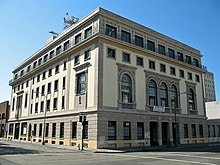
Julia Morgan's affiliation with the YWCA began when Phoebe Apperson Hearst recommended her for the organization's Asilomar summer conference center, a project she began in 1913. The Asilomar Conference Center, no longer YWCA but State-run, is still in Pacific Grove near Monterey, California. Morgan also designed YWCAs in California, Utah, Arizona, and Hawaii.
Five of the Southern California YWCA buildings were designed by Morgan.[29] The 1918 Harbor Area YWCA (San Pedro, CA) in a Craftsman building is still standing, as is the 1926 Hollywood Studio Club YWCA. Morgan's Riverside YWCA from 1929 still stands, but as the Riverside Art Museum. Her 1925 Long Beach Italian Renaissance branch has been demolished. The "gorgeous" Pasadena YWCA is being acquired by the City for restoration and public use after several decades of decay.[29]
Morgan also designed YWCA buildings in Northern California, including those in Oakland and in San Francisco's Chinatown. The YWCA building in San Francisco reflects her understanding of traditional Chinese architecture. The building was restored in 2001 by the Chinese Historical Society of America (CHSA), and now houses the Chinese Historical Society of America Museum and Learning Center.
Mills College
Morgan made many architectural contributions to Mills College, a women's college in the
Mills president Susan Mills became interested in Morgan in 1904 because she wished to further the career of a female architect and because Morgan, who was early in her career, charged less than her male counterparts.[30] Morgan designed six buildings for the Mills campus, including El Campanil, believed to be the first bell tower on a United States college campus.[30] (El Campanil should not be confused with The Campanile, a nickname for Sather Tower, the bell tower of nearby UC Berkeley.) Morgan helped draft parts of the UC Berkeley campus under John Galen Howard, but the Sather Tower was not her design. Despite being chosen by Mills to design El Campanil and her academic credentials, coworkers like Bernard Ransome, son of Ernest Ransome, did not trust in her abilities as a true concrete expert.[10] Ransome's undermining of Morgan's ability led to less trust in her work and praise veiled in gendered rhetoric at the time. For example, a speaker at the dedication ceremony praised El Campanil for being "reared by the genius of a woman's brain."[10]
Morgan's reputation grew when the tower was unscathed by the 1906
Morgan also designed the
Heritage on the Marina

From 1922 to 1925, Julia Morgan was enlisted to design a nursing home to house elderly women in San Francisco. Today the building is home to Heritage on the Marina, San Francisco’s premier Life Plan Community. The beautiful Julia Morgan building is owned and operated by the San Francisco Ladies’ Protection and Relief Society, one of California’s first philanthropic organizations, established in 1853.
Other projects

Among her earliest works was the North Star House in Grass Valley, California, commissioned in 1904-5 by mining engineer Arthur De Wint Foote and his wife, the author and illustrator Mary Hallock Foote.
She considered St. John's Presbyterian Church, in Berkeley, California, her finest Craftsman-style building.[32] It is now the Berkeley Playhouse.[33]
Other projects include the
Some of her residential projects, most of them located in the
Morgan designed two houses in Monterey County, California. One, designed by Morgan in 1915, is the "Little Cottage of River Winds" at 26184 Carmelo Street at Carmel Point, outside the Carmel-by-the-Sea city limits.[36] The other is the "Dr. Emma W. Pope House" at 2981 Franciscan Way, on a hillside overlooking the Carmel Mission. It was built in 1940, in the Minimal Traditional architectural style for Dr. Emma Whitman Pope, who was a friend from Morgan's undergraduate years at the UC Berkeley.[37]

Personal life
Although Morgan was highly respected as an architect, not much is known about her personal life. She was never married and had no known romantic relationships. She kept a low profile and lived modestly, in spite of her wealthy clientele. Colleagues and acquaintances were surprised by her modest sense of fashion, a coworker even went as far as saying that Morgan dressed like a "nobody."[10] Morgan gave few interviews and did not write about herself.[10] Early interviews used gendered rhetoric to speak about her accomplishments and early newspaper articles followed her progress at the École des Beaux Arts.[38][39] After that she mostly avoided interviews and only agreed to articles that focused on her work to advance her reputation.[10] She worked tirelessly on minimal sleep and food.[3]
Morgan was very independent. During her transition to Paris she had a fund given to her by her parents for all of her first-year expenses. Even when her funds ran out, she never asked her family for any extra money, but instead learned to live on a tight budget. This experience gave her a concrete understanding of how to handle money efficiently, which helped make her a successful businesswoman after she opened her own practice, and helped her to focus on keeping her projects within her client's budgets.[40]
One of the few public awards she accepted was the University of California, Berkeley, honorary Doctor of Laws degree, its highest award, conferred upon her on May 15, 1929, with the following personal tribute: “distinguished alumna of the University of California, artist and engineer; designer of simple dwellings and of stately homes, of great buildings nobly planned to further the centralized activities of her fellow citizens; architect in whose works harmony and admirable proportions bring pleasure to the eye and peace to the mind.”[10]
Intrigued with the gaps in Julia Morgan's life story, Belinda Taylor, wrote Becoming Julia Morgan, a 2012 play in which Taylor imagines a plausible life story for Morgan.[41]
Death and legacy
My buildings will be my legacy... they will speak for me long after I'm gone.
— Julia Morgan
Julia Morgan died on February 2, 1957, in San Francisco, California, at age 85. Her body was buried in the Mountain View Cemetery in the hills of Oakland, California.[42]
In 1995, the Julia Morgan Ballroom at the Merchants Exchange Building in San Francisco, where she had her office from 1907 to 1950, was named in her honor.[43]
In 1999, a
In 2006, a children's picture book titled Julia Morgan Built a Castle was published and is available in many public libraries.[44]
On May 28, 2008, California Governor
Julia Morgan was the 2014 recipient (posthumous) of the AIA Gold Medal, the highest award of the American Institute of Architects (AIA). She was the first female architect to receive this honor.[46]
Sketches
-
Watercolor of the Tour Cesar, Provins, France, circa 1898 By Julia Morgan
Gallery
-
Ceiling of the Julia Morgan Ballroom, Merchants Exchange Building, San Francisco
-
Julia Morgan House, Sacramento, California
-
Julia Morgan Hall
-
Girton Hall, Berkeley
See also
References
- ^ a b (fr) Agorha.inha, Biographie rédigée par Marie-Laure Crosnier Leconte Archived 2016-10-13 at the Wayback Machine
- ^ ISSN 0094-0178.
- ^ a b Erica Reder: "Julia Morgan was a local, in The New Fillmore, 1 February 2011. Retrieved 2015-10-23.
- ^ Filler, Martin. "Xanadu's Architect". Retrieved 3 September 2022.
The mother of them all was Julia Morgan, the prolific San Francisco Bay Area architect who completed more than seven hundred buildings.
{{cite magazine}}: Cite magazine requires|magazine=(help) - ^ Littman, Julie (March 7, 2018). "Bay Area Architect Julia Morgan's Legacy Wasn't Just Hearst Castle". busnow.com. Retrieved 18 April 2019.
- OCLC 34546312.
- ^ Wendy Moonan: "AIA Awards 2014 Gold Medal to Julia Morgan", in the Architectural Record, 16 December 2013
- ^ Rochlin, Harriet (March 1976). "Designed by Julia Morgan". Westways. 68 (3). Automobile Club of Southern California: 26–29, 75–76, 80.
- ^ ISBN 978-0-8225-4903-1.
- ^ .
- ^ McNEILL, KAREN. “Julia Morgan: Gender, Architecture, and Professional Style.” Pacific Historical Review 76, no. 2 (2007): 229–68. https://doi.org/10.1525/phr.2007.76.2.229.
- ^ JSTOR 23215875. Archived from the original(PDF) on 2015-09-23. Retrieved 2012-07-22.
- ^ a b c "Julia Morgan - Hearst Castle". hearstcastle.org. 2012-11-15. Retrieved 2024-01-18.
- )
- ^ McNEILL, KAREN. “Julia Morgan: Gender, Architecture, and Professional Style.” Pacific Historical Review 76, no. 2 (2007): 229–68. https://doi.org/10.1525/phr.2007.76.2.229.
- ISSN 0021-8529.
- ^ ISBN 978-1-4236-0088-6.
- ^ McNEILL, KAREN. “Julia Morgan: Gender, Architecture, and Professional Style.” Pacific Historical Review 76, no. 2 (2007): 234. https://doi.org/10.1525/phr.2007.76.2.229.
- ^ Reichers, Maggie (September–October 2006). "Beyond San Simeon". Humanities. 27 (5). Neh.gov. Archived from the original on 2012-02-22. Retrieved 2012-09-07.
- ^ "Julia Morgan: Early Architect. California State Capitol website". Archived from the original on June 23, 2007. Retrieved 2009-05-26., Retrieved 2009-05-26
- ^ Stevens, Suzanne (May 2014). "A woman for all reasons: Julia Morgan's impressive legacy of architectural achievements from her 45-year practice in San Francisco has won her the AIA Gold Medal for 2014". Architectural Record. 202: 58–60, 62, 65 – via EBSCOhost.
- ^ "Pioneering Women of American Architecture". pioneeringwomen.bwaf.org. Retrieved 2024-03-27.
- ^ "El Campanil, Mills College: Julia Morgan 1903–1904". Retrieved 18 April 2019.
- ^ Callen, Will (February 4, 2019). "Julia Morgan-designed Mills bell tower counts down to its 115th anniversary". hoodline.com. Retrieved 18 April 2019.
Morgan had studied the material in Paris, where some of its pioneers, François Hennebique and Auguste Perret, were exploring its non-industrial uses. Fascinated by its combination of stability and plasticity, she may have been the first architect in the U.S. to put it towards something other than bridges or piers.
- ^ Morgan, Julia. "Julia Morgan". Encyclopedia Britannica.
- .
- ^ Berkeley Bohemia: Artists and Visionaries of the Early 20th Century. 2008. p. 132.
The company was chosen by the castle's architect, Julia Morgan, who personally designed many of the tiles that were made
- ^ "Babicora, Mexico: End of An Empire". Time. 7 September 1953. Retrieved May 11, 2010.
- ^ a b Bariscale, Floyd B. (October 1, 2008). "No. 186 – Morgan House (Harbor Area YWCA)". Big Orange Landmarks. Retrieved May 11, 2010.
- ^ a b c d e f g h Ito, Susan (Winter 2004). "Julia Morgan at Mills". Mills Quarterly. Mills College. p. 14. Retrieved 2020-11-18.
- ^ a b c d Mills College 2007/2008 Undergraduate Student Handbook (PDF). School Datebooks. 2007. Archived from the original (PDF) on 2008-05-12. Retrieved 2008-02-27.
- ^ Hines, Thomas (September 4, 1988). "An Architect from the Inside Out: Julia Morgan, Architect". Los Angeles Times. Archived from the original on 2020-11-29. Retrieved August 11, 2022.
- ^ Thompson, Daniella. "Berkeley Landmarks: St. John's Presbyterian Church". Berkeley Architectural Heritage Association. Retrieved 2012-09-07.
- ^ "MacArthur Park". Macpark.com. Retrieved 2012-09-07.
- ^ "San Jose's Julia Morgan House" (PDF). Continuity: 11. Summer 2009.
- ^ Tamara Grippi (March 30, 2001). "An historic gem discoverd in Carmel". Carmel Pine Cone. Carmel-by-the-Sea, California. p. 1. Retrieved 2023-04-01.
- ^ "Carmel Historic Survey Volume Blocks a69". Costal Commission. Carmel-by-the-Sea. December 19, 2012. Retrieved 2023-04-01.
- .
- JSTOR 23215875– via JSTOR.
- ^ Wilson, Mark Anthony (2007). Julia Morgan Architect of Beauty. Utah: Gibbs Smith. pp. 1, 4.
- ^ Erica Reder, ed. (2012). "Belinda Taylor presents: Becoming Julia Morgan". Archived from the original on July 22, 2018.
- ^ Mountain View Cemetery
- ^ "About the Historic Julia Morgan Ballroom Event Space in San Francisco". Julia Morgan Ballroom. Archived from the original on 2020-07-16. Retrieved 2018-02-10.
- OCLC 56051019.
- ^ "Governor & First Lady Participate in 2008 CA Hall of Fame Induction Ceremony". State of California, Office of Governor. Archived from the original on 2015-06-02. Retrieved 2013-05-20.
- ^ "2014 AIA Gold Medal Awarded to Julia Morgan, FAIA" (Press release). American Institute of Architects. Archived from the original on 2013-12-13. Retrieved 12 December 2013.
46. Encyclopædia Britannica, inc. (2024, January 29). Julia Morgan. Encyclopædia Britannica. https://www.britannica.com/biography/Julia-Morgan
Further reading
Books
- Boutelle, Sara Holmes (1988). Julia Morgan, Architect New York: Abbeville Press. [ISBN missing]
- Harris, Gloria G.; Cohen, Hannah S. (2012). "Chapter 9. Architects". Women Trailblazers of California: Pioneers to the Present. Charleston, SC: The History Press. pp. 136–50 [137–40]. ISBN 978-1609496753.
- Kastner, Victoria (2022). Julia Morgan: An Intimate Biography of the Trailblazing Architect. San Francisco: Chronicle Books. ISBN 978-1797205632.
- Lewis, Anna M. (2014). Women of Steel and Stone: 22 Inspirational Architects, Engineers, and Landscape Designers. Chicago, IL: Chicago Review Press. p. 88. ISBN 978-1-61374-511-3.
- Morgan, J. (1976). Architectural drawings by Julia Morgan: beau-arts assignments and other buildings. Oakland, Calif: Oakland Museum, Art Dept.
- Morgan, J., Hearst, W. R., & Loe, N. E. (1987). San Simeon revisited: the correspondence between architect Julia Morgan and William Randolph Hearst. San Luis Obispo, Calif: Library Associates, California Polytechnic State University.
- Morgan, J. (1987). Berkeley houses by Julia Morgan. Berkeley, California: The Association.
- Perry, Phillis J. (2018). All About Julia Morgan. Indianapolis, Indiana, Blue River Press ISBN 978-1681570952.
- Wilson, Mark A. (2007). Julia Morgan: Architect of Beauty. Salt Lake City, Utah: Gibbs Smith.
Reviews
- Kastner, Victoria. (2003). "Morgan and Associates: Julia Morgan's Office Practice as Design Metaphor." 20 on 20/20 Vision. Boston: AIA Diversity Committee/Boston Society of Architects, pp. 44–51.
- Longstreth, R. W. (1977). Julia Morgan, architect. Berkeley Architectural Heritage publication series, no. 1. Berkeley, California: Berkeley Architectural Heritage Association.
- McNeill, Karen (May 2007) "Julia Morgan: Gender, Architecture, and Professional Style." Pacific Historical Review, pp. 229–67.
- McNeill, Karen (Summer 2012) "'Women Who Build: Julia Morgan & Women's Institutions." California History, pp. 41–74.
- Pasadena Cultural Heritage Commission. (1988). Report on reuse of the Julia Morgan YWCA building: YWCA & YMCA Pasadena, California. New York: Halsband.
- Quacchia, R. L. (2005). Julia Morgan, architect, and the creation of the Asilomar Conference Grounds: including a comparison with Hearst Castle. Virginia Beach, Virginia: Q Pub.
- Steilberg, W. T., & Morgan, J. (1983). Some examples of the work of Julia Morgan. San Francisco: Architect and Engineer of California.
- University of California, Berkeley. (1986). Julia Morgan, architectural drawings: inventory of holdings, College of Environmental Design. Berkeley: The College.
Article
- Hawthorne, Christopher. “Julia Morgan: Her Quietly Revolutionary Architecture -- a Blend of Beaux-Arts and Bay Area Influences -- Is Finally Earning Its Due.” Architect (Washington, D.C.) 103, no. 6 (June 1, 2014): 170–79.
External links
- Overlooked No More: Julia Morgan, Pioneering Female Architect
- Pioneering Women of American Architecture, Julia Morgan
- Beverly Willis Architecture Foundation, Episode 1: Finding Julia Morgan
- The Julia Morgan Collection at Cal Poly San Luis Obispo
- Julia Morgan – An Online Exhibition Archived 2013-07-30 at the Wayback Machine
- Julia Morgan Collection at the Environmental Design Archives
- Hidden Engineer: The Designs of Julia Morgan
- Julia Morgan Architectural Drawings, 1907–1929, The Bancroft Library
- Index of Buildings by Julia Morgan
- Julia Morgan, Beverly Willis Architecture Foundation Dynamic National Archive at archive.today (archived December 12, 2013)
- One Woman’s Contribution to Arts and Crafts Architecture
- Julia Morgan "Spotlight on Women in Design"
- Julia Morgan 2012
- Morgan (Julia) Collection, 1893–1980

